Thanks to the NHL’s new playoff format, we were treated to some excellent second round matches this post-season. We’ve already gone over the heated Capitals-Penguins series in the Eastern Conference and the seven-game thriller between the San Jose Sharks & Nashville Predators. Now, we turn our attention to the Central Division, as we’re about to take a closer look at the great series between the St. Louis Blues and Dallas Stars.
Most second round matchups tend to be fairly close on paper, and this was especially true here. Dallas finished only two points ahead of St. Louis in the standings and both clubs were ranked right next to each other in Score Adjusted Fenwick, Dallas ranking 6th and St. Louis ranking 7th respectively. The Blues might have a slight edge when it comes to playoff experience, but predicting this series was basically a coin flip, which is what makes it such a great matchup.
What also made this an interesting matchup is that you have two teams with contrasting styles. Both were very strong in terms of controlling territorial play, but Dallas was a high-scoring team, ranking third in the league in 5v5 Goals For per 60 minutes while also being a Top 5 team in terms of shots per game. St. Louis, on the other hand, posted one of the strongest Goals Against per 60 rates in the league and were a Top 10 team in both shot generation & shot suppression. Dallas is also known for being a quick, skilled team that outscores most of their problems (i.e. defense & goaltending issues) while the Blues have the reputation for being a “heavy” team that wins games on the back of their strong defensive play.
Did the offensive powerhouse or the strong defensive team end up coming out on top? The answer is neither and we’ll found out why after the jump.
5v5 Shot Attempts

Overall, Dallas ended up with the advantage in most of the shot categories. The numbers are pretty similar to the Blues matchup against the Chicago Blackhawks, where they ended up winning the series despite getting outshot by a decent margin. What is also similar to that series is that the Blues created most of their shots after they were able to carry the puck into the zone or force a turnover, although they relied a lot more on carry-ins this round. They also spent a lot of time playing with a lead, as their three worst territorial performances came in games where they played with a lead and went into a shell for the majority of the third period (Games 2, 5 & 7 to be specific). So the final results are score-effects driven to an extent.
Still, Dallas gave the Blues just about all they could handle this series, score effects or not. They were creating 14 scoring chances a game at even strength alone and made Blues goaltender Brian Elliott do a lot of work to keep his team in front. They were doing their best to take away his vision with screens, getting close to the net to jump on rebounds and, most importantly, moving the puck around in the offensive zone to make his job as difficult as possible. Elliott stood his ground for the most part, Game 6 aside, and played a big role in the Blues closing out this series. Yes, St. Louis won a couple of blowouts, but Elliott did a great job of keeping things from getting out of hand and came up huge when he needed to.
At the other end, Dallas’ goaltending wasn’t as solid. That’s probably being nice because both Kari Lehtonen & Antti Niemi were pulled twice this series and both posted save percentages below .900. It’s tough to think of a word to describe their performance because “inconsistent” or “bad” doesn’t quite do it justice. Lehtonen had two games where he was outstanding and the Stars might have been eliminated earlier if it wasn’t for that. Outside of those games, however, the Stars goaltenders were a mess and had their team playing catch-up for most of this series.
This is how things have been for them all season, though. Dallas had one of the worst team save percentages in the league and went back-and-forth between Lehtonen & Niemi over the course of the year. It’s easy to look at the numbers above and conclude that the team with the worse goaltending lost, but how much of it was on them? As bad as the Stars goaltending has been this year, they have also been criticized for terrible defensive play and leaving both netminders out to dry. The Blues were getting most of their shots off carry-ins or turnovers and a higher percentage of these shots were scoring chances, so perhaps there is some truth to that. The shot zone data also has some evidence in favor of this argument.
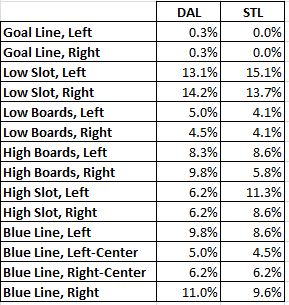
If you add the percentage of shots each team was getting from the slot areas, you’ll notice the Blues had nearly 49% of their shots come from those specific zones, compared to only 39.7% of the Stars. Both teams did a pretty good job of working the low slot and getting shots from close-range, but the high-slot seemed to be more open for the Blues than it was for Dallas. This isn’t an excuse for the Stars goaltending , as both Lehtonen & Niemi could have been a lot better, but the Blues seemed to exploit a certain area of the ice well and that area also happened to be a very dangerous spot on the ice. The Stars, meanwhile, were pushed more to the outside instead of the high slot and tried more screened shots from these areas.
5v5 Zone Entries

How both teams attacked the neutral zone was pretty interesting to watch because it went against the whole narrative of this being a Skill vs. Grit clash. St. Louis is a sound defensive team, yes but they also have a lot of skill and be a team that hurts you in transition just as much as they can by wearing you down in the offensive zone. They did more of the former in this series, generating the majority of their shots off the rush and carrying the puck in on over 52% of their entries. In fact, when they were dumping the puck in, they weren’t seeing much of a reward for it and Dallas was creating more shots this way than the Blues were, which was a little surprising.
Both teams seemed to be able to do what they want in the neutral zone and this series ended up being more of a track meet than anything else. It’s interesting because Dallas was forced to dump the puck in more than they would have liked against Minnesota but they had no problems getting the Blues defense to back off in this series. The Blues, however, also got the better of Dallas’ defense here and they also had more overall entries, which helped even the gap a little.
The Blues also destroyed the Stars in the goal department here, which is inflated a bit by Games 3 & 7, but those games still happened and Dallas got burned on the rush a few times during then. St. Louis scored all of their five-on-five goals on entries and the massive goal-differential here pretty much negated Dallas’s advantage in the shot department. Part of that is due to the Stars goaltending problems & them getting beat on a lot of first-shots, but I mentioned earlier that the Blues were exploiting certain areas of the ice and we’ll look into how their neutral zone play tied into that.
St. Louis Blues 5v5 Zone Entries

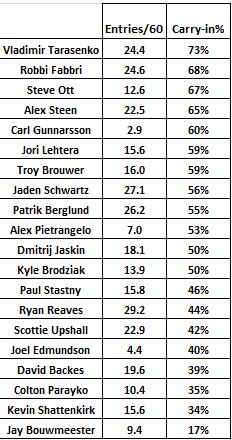
If you refer back to the previous chart, you’ll remember that the Blues were carrying the puck in on a high percentage of their entries and creating most of their shots this way. This was led by the Schwartz-Lehtera-Tarasenko line, who basically refused to dump the puck in whenever they had it on their stick in the neutral zone. Robby Fabbri, Patrick Berglund & Alex Steen also had very good showings here and were the primary puck-carriers on their respective lines. Fabbri & Steen each spent some time on a line with Paul Stastny & Troy Brouwer, and their play in the neutral zone created some space for these two to work with and they seemed to thrive on it. Stastny & Brouwer were two of St. Louis’ most effective offensive players, so this system seemed to work well for St. Louis. Brouwer was especially good at being a support guy and finding open spaces in the offensive zone.
The Blues also seemed adamant about having their defense join in the rush, much more than we’ve seen from other teams in the playoffs so far. Shattenkirk & Parayko were given the green light to go more often than others, but Pietrangelo was also very good in this department and was a key part of the Blues gameplan in the neutral zone. St. Louis also made it easy for their defense to carry the puck in when they needed to, overloading one side of the ice & drawing the defending team in and giving the weak side player a free pass into the zone.
Having support is also a key for the Blues neutral zone play, as they did a great job of going up the ice as a group and making sure the guy entering the zone had a passing option so that he wasn’t just firing a low-percentage shot at the net. Very similar to what Ryan Stimson looked at here when looking at the Dallas Stars breakouts & zone entries.

Here we see the Blues breaking out of their zone with the Schwartz-Lehtera-Tarasenko line. Dallas had two forecheckers in on the play (first one not pictured) and the Blues were able to beat them and get out of the zone with a couple of short passes. Both teams are currently making a partial line change too, so there is a little more space to work with here. Schwartz now has the puck and is looking for Lehtera in the center of the ice.
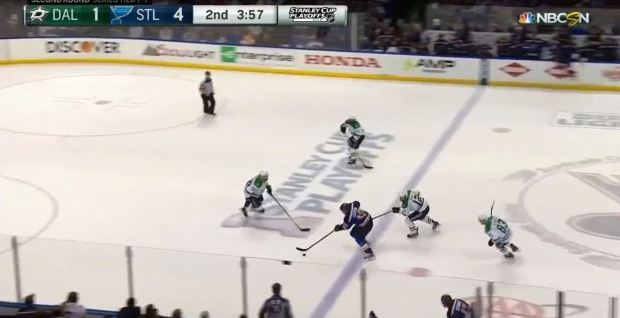
Lehtera receives the pass and is able to make his way through center ice fairly easily. It looks like he’s running into a trap, though because the situation is currently two-on-four. Dallas overloaded that side of the ice and is looking to stop Lehtera on the boards. The play looks like it’s destined to fail, but coming down the left wall is Schwartz, so Lehtera has some support.
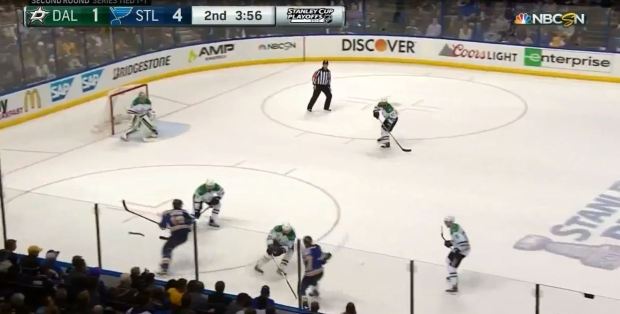
Lehtera makes a behind-the-back drop pass that every coach loves and is able to connect with Schwartz. You can see that Schwartz is looking to go cross-ice with the puck, which means there is a third-man coming. Dallas is currently puck-focused, so if there is one he will probably end up being wide open.

Tarasenko shows up out of nowhere, receives the pass from Schwartz and gets a good scoring chance away from the high slot, one of the areas St. Louis exploited. Dallas overplayed the left side of the ice and left that wing wide open, so Tarasenko was able to get a shot off without much of an issue. The farside defenseman (Oduya) was so out of position that he couldn’t get over to block or prevent the shot in time. All of this started with a quick breakout and an entry with a passing option, something St. Louis was adamant on doing all series.
They weren’t the only team that had success in the neutral zone, though.
Dallas Stars 5v5 Zone Entries
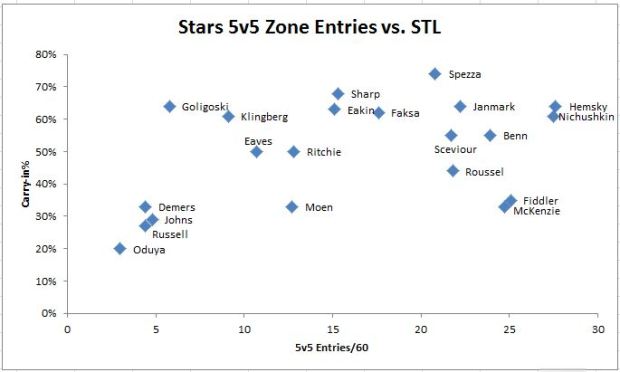
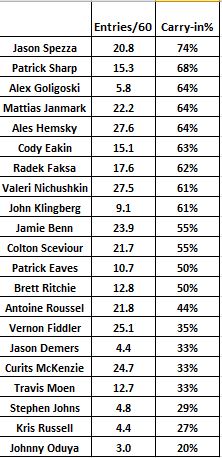
You’ll recall that Dallas had a carry-in percentage and were very successful at creating shots regardless of how they entered the zone. Thus, all but four of their forwards ended up with Carry-in rates above 50% they made it a priority to get the puck to their most skilled players when they were in the neutral zone. Their entire top-six ended up above the 50% threshold with Hemsky, Nichushkin, Benn, Janmark & Spezza leading the way. Eakin, Faksa & Sharp also did well in limited roles and even some depth players like Eaves & Sceviour had success when they were asked to handle the puck in the neutral zone. Pretty much everyone who played decent minutes carried the puck in at a high rate with the exception of Antoine Roussel.
Ever since Lindy Ruff took over, Dallas’ system has been built around making plays with the puck and being as creative as possible offensively. It’s difficult to run this type of system in a league that’s so focused on defense and shutting down the other team, so Dallas does a lot of things to make it easy as possible for them to carry the puck in and get a decent shot off once they do get it into the zone. Ryan diagramed many of these in the Hockey Graphs post I linked to earlier, and we saw many of them in action in the playoffs.
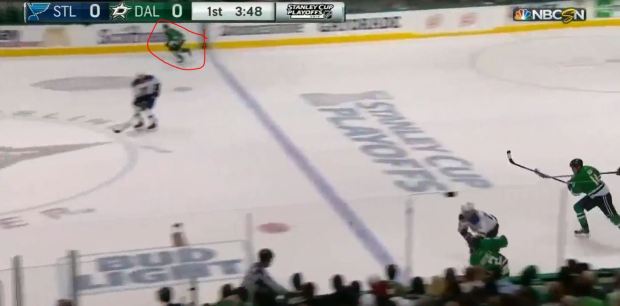
Here we see Dallas defenseman Kris Russell breaking the puck out of the zone. He’s currently being pressured by the Blues forechecker, but has a passing option across the rink in Cody Eakin and support coming in Jamie Benn. If he gets the pass off quick enough, Eakin probably has a lane into the zone.

Russell makes the pass and St. Louis defense backs off since Dallas currently has three players coming into the zone at top speed. The one positive for the Blues is that the play is on the wall right now, so if Eakin were to shoot the puck, it wouldn’t be very dangerous, but you’ll notice I have Jamie Benn circled and we’re about to see why.
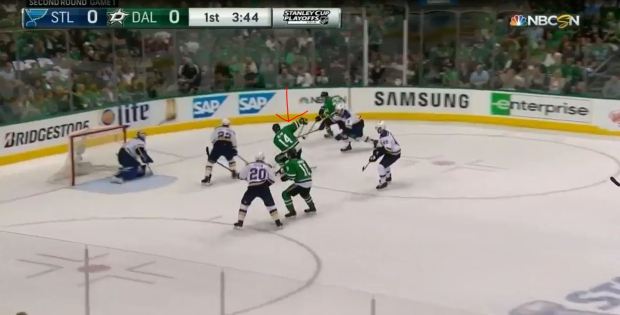
Eakin continues to go down the wall, drawing Gunnarsson to him, while Benn drives the center lane. He eventually tries to center to Benn in the middle of the ice. Benn’s shot ended up missing the net, but it’s a decent chance generated by Dallas and all it took was a quick east-west breakout with strong middle lane drive. They also had Sharp camped out at the far blue line as another thing the Blues had to pay attention to, which gave Benn some space to work with. As Ryan noted in his post, Dallas typically has a forward fly the zone on a breakout to act as passing option once they cross the blue line. Sometimes they had all three camped out for a stretch pass like this:
The Dallas defense corps also stands out here, namely their first pairing of Alex Goligoski and John Klingberg. These two were given the green light to go whenever they wanted and you can see that they had a lot of fun with it. They carried the puck in as often as their top-six did and Klingberg basically acted like a fourth forward whenever Dallas was coming up the ice. They were often paired with the Benn line, so perhaps that’s where the extra trust comes from but both Klingberg & Goligoski are very dangerous with the puck, so it makes sense to get the most out of your roster like that. The rest of the defense finds themselves lumped in the same part of the graph with Demers, Johns & Russell doing an average job of carrying the puck in when they were asked to. It’s hard to compare them to the first pair because it looks like they were given a completely different role in the neutral zone, at least with the puck. Without the puck, everyone on the Stars was encouraged to join the play.

This is Dallas’ fourth line entering the zone with Vernon Fiddler doing the honors. They have three guys in the rush with a fourth man coming at the bottom of the picture. St. Louis’ defense is giving them quite a bit of respect here (possibly because there’s a forward back to help break up the play), so Dallas has plenty of room to carry the puck in if they want to.

Dallas gains the line with control with Demers jumping into the play. It’s unknown if the Blues left defensemen recognizes this because his attention is currently on Fiddler & Sceviour.
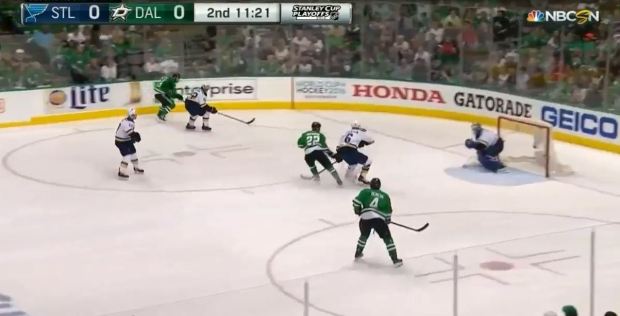
Fiddler is pushed to the outside by Shattenkirk and he is forced to take a shot from a bad angle, presumably what he didn’t want to do. However, Dallas has an outnumbered situation in front of the goal with Demers being wide open. The Blues were fixated on the two oncoming forwards that the rushing defensemen wasn’t picked up. Luckily for them, all that has to happen is for Elliott to freeze the puck and the play is over.
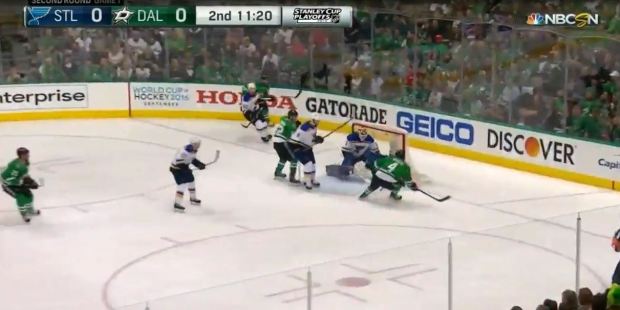
Instead, Fiddler purposely shoots the puck off of Elliott’s pads and Demers has a golden chance on the rebound, virtually uncovered because the Blues didn’t read the situation well. This happened to St. Louis frequently early in the series, as they couldn’t handle Dallas’ speed in the neutral zone and it seemed like they added a new layer to their attack every game. Things eventually settled down for them, though and Ken Hitchcock found ways to disrupt some of Dallas’ breakouts and keep them from gaining speed in the neutral zone, especially as he started to get the matchups he wanted.
This moment from Game 3 is a good example:
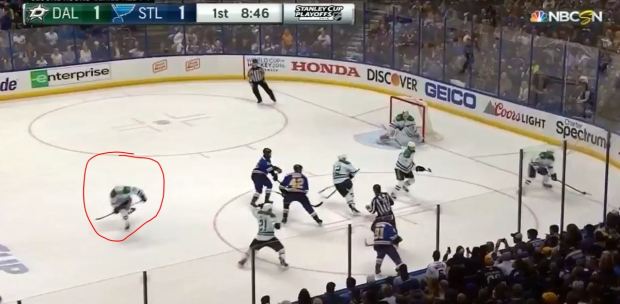
The Blues send out Backes, Tarasenko & Fabbri for an offensive zone faceoff against the Radek Faksa’s line along with Russell & Demers on defense. This is definitely a favorable matchup for St. Louis. The Stars are setting up their breakout with Russell going towards the wall and Hemsky flying the zone looking for a pass. Roussel is also there to act as a passing option but he lost his stick, so things are off time for about a second.
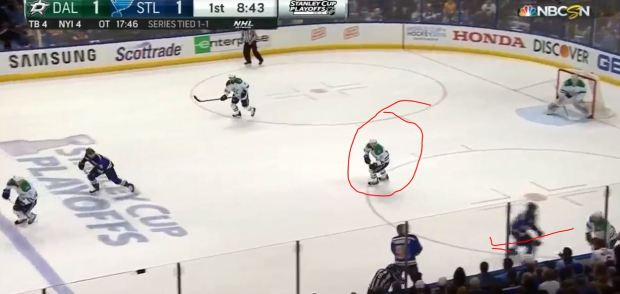
Russell continues to go up the wall, presumably looking for Hemsky, but the Blues cut off the lane. He has an easier passing option in Roussel (and potentially Faksa), but there’s two Blues players right in his face, so Russel ends up panicking and sends the puck up the wall.

The puck is predicably turned over and Tarasenko is able to setup Fabbri in the high slot for a good scoring chance with Backes causing a disturbance in front of the net. Turnovers lead to breakdowns and dangerous areas on the ice are going to open up (like the high slot) when you have guys scrambling back into position. The Blues made a point to do pressure Dallas’ breakouts and force turnovers after they were carved up in the neutral zone in the first two games.
Another example of this came later in Game 3 where they were able to disrupt a more controlled breakout by Dallas.

John Klingberg currently has the puck and the Stars should be able to get out of their zone relatively easily, as the Blues have only one forechecker and Klingberg has three options he can go to.
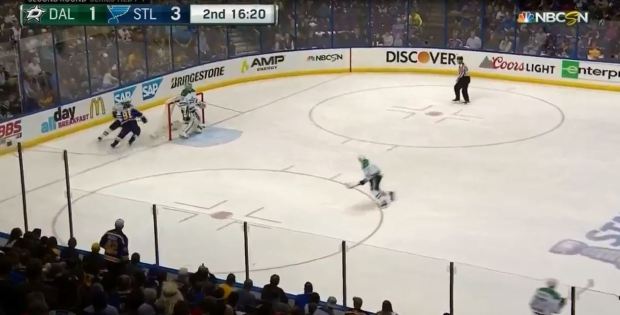
Klingberg ends up being a little too patient with the breakout and Tarasenko chases him around the net. All three of Dallas’ forwards haven’t flown the zone yet, but Eakin is the only one left and Klingberg making a pass to him now is a bit of a high risk play since Tarasenko forced him behind the net.
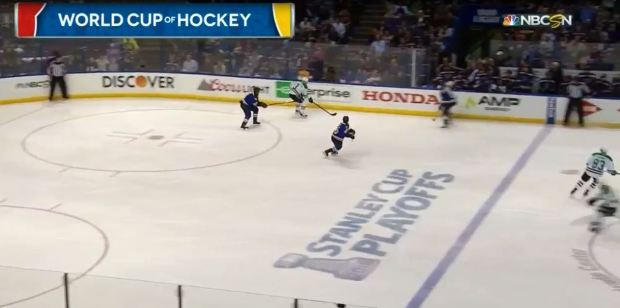
Klingberg tries to skate himself out of trouble and runs into three St. Louis players. All three Dallas forwards are gone at this point, so the most he can do here is clear the puck off the boards or into the bench.

Instead, he hangs onto the puck a little longer than he probably should have and the puck is turned over. St. Louis eventually scored on this play, so it ended up being a double-whammy for Dallas. Klingberg is normally a lot more efficient at finding an out when he’s in trouble, but Tarasenko did a great job of leading him into a trap by being aggressive on the forecheck.
Both of these plays are interesting to go over because Dallas still had an advantage over St. Louis when it came to carrying the puck through the neutral zone. St. Louis didn’t have an answer for that, so their solution was to stop Dallas’ breakouts at the source and keep the puck from getting into the neutral zone all together. It worked like a charm in Game 3 and they had some success with this over the remainder of the series.
St. Louis 5v5 Shots & Passes

St. Louis changed up their lines throughout the series, so picking one standout is tough. That said, Brouwer might have been their best forward all series, from an offensive standpoint at least. He did a little of everything and showed some great chemistry with both Paul Stastny & Robby Fabbri. Brouwer was one of their many players who consistently found open spots in the Stars defense and made the most of his opportunities. Fabbri was also very effective here, ranking second in primary shot assists per 60 minutes. Combine that with his work as a puck-carrier in the neutral zone and he also ended up being a very important player. Stastny also did well for himself, although most of his opportunities came off rebounds or Brouwer setting him up close to the net.
Tarasenko also had a solid series, leading the Blues in shots by a wide margin and doing a lot of work on his own. Both Lehtera and Schwartz put up pretty low numbers for their standards and 12 of Tarasenko’s 30 shot attempts came without an assist, so he had to carry some of the weight on his own. Part of that is due to Schwartz & Lehtera not getting open in the offensive zone as much as usual, leaving Tarasenko with not as many options.
Also posting low shot numbers are most of St. Louis’ defense, which was a little surprising with how talented the Blues defense corps is producing offense. However, the Blues ended up using this to their advantage, as Dallas was taking away the points for most of the series. This opened up opportunities for other players.

This is shortly after a faceoff. You’ll notice that Dallas sent a forward out to Kevin Shattenkirk’s lane to pressure him and possibly block a shot. The Blues work the play around to the other side of the ice to Joel Edmundson, who is less likely to take a shot and make a play than Shattenkirk.

Not being the best play-maker, Edmundson reads this situation well and works the puck down to Backes on the wall. Dallas still has a forward out at the point and it opens up some space in the slot area where both Patrick Berglund & Robby Fabbri are lurking.

Backes has enough space to setup the high forward Fabbri for a one-timer and Niemi has to move laterally to make the save. Dallas recovered just in time to get someone on Fabbri, but it was a little too late and could have been a lot worse if they didn’t read this play in time. Just another example of how the Blues were able to get the puck to this particular area.
5v5 Dallas Stars Shots & Passes

Dallas’ offensive distribution ended up being way more top-heavy than St. Louis with one person doing the bulk of the work on each line. On the first line, Jamie Benn carried the load and got some help from Patrick Sharp, both as a shooter and a passer. I thought Sharp had a quiet series for his standards and when you look at how effective Benn was as a passer, it’s a little surprising that he didn’t have more shots. Him being behind Sceviour & Eaves in this department is also pretty glaring, but St. Louis seemed to do a decent job of covering him and Cody Eakin was playing out of his depth as the first line center.
Jason Spezza & Valeri Nichushkin carried the second line with Janmark struggling to find much of a rhythm as a passer. Ruff never tried to load up the first line (at least not for an entire game) but it would have been interesting to see Spezza & Benn spend more time together, even if it would cause some depth problems with the second & third lines.
Speaking of which, Ales Hemsky absolutely killed it on the third line and saw virtually no reward for it, recording only one assist all series. It’s unfortunately because this was some of the best hockey he played in a Stars uniform but he just couldn’t catch a break on either end. Even if you argue that he wasn’t creating chances (he was), his linemates not finishing is totally out of his control as both Roussel & Faksa were snake-bitten as well. It’s too bad because maybe this series ends up differently if this line gets a few goals, but they ended up not producing much despite playing well in other areas and it put the Stars behind a little.
Also clumped together with the group of forwards on the graph is defensemen John Klingberg & Alex Goligoski, who were the Stars best playmaking defensemen by a mile. Like I said earlier, they were given the greenlight to do just about anything they wanted and it paid dividends, as both nicely contributed to the offense, even outperforming some of their forwards. That said, as active as these two were, the only other defensemen who got involved in the offense consistently was Demers, but most of it stems from the Oduya-Johns having a different role and playing a more conservative style.
The Final Word
This was a tough, well-earned series win for the Blues and they did it on the back of their offense and taking advantage of some of Dallas’ miscues in the defensive zone. They had to take some lumps in the first couple of games, but they developed a good counter strategy and eventually found some holes in Dallas’ game. The advantage they had in goal obviously played a huge role too, as Elliott had to come up big in a couple of games for them, especially while they were defending a lead. Dallas is a great team, though and it will be interesting to see what they can do next year with a different-looking roster.

































